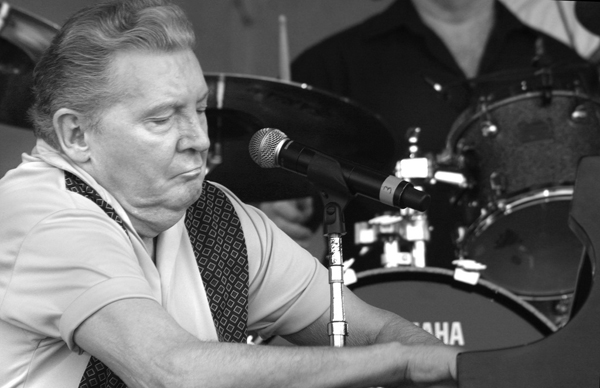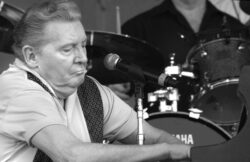Jerry Lee Lewis
Jerry Lee Lewis was one of the founding fathers of rockabilly music.

GARY LOVERDE
Jerry Lee Lewis performing at the New Orleans Jazz and Heritage Festival, 2007.
Along with Elvis Presley, singer/pianist Jerry Lee Lewis was revered as a founding father of rock ‘n’ roll music in general, and the country-tinged rockabilly genre in particular. Lewis forged his rockabilly sound from an organic, exciting, and fully realized blend of blues, rhythm and blues (R&B), country music, and western swing that pulsed with equal measures of gospel-music fervor and intense sexuality. One of the first inductees into the Rock and Roll Hall of Fame in 1986, Lewis is also a member of the Rockabilly Hall of Fame.
Early Life and Musical Influences
Lewis was born September 29, 1935, in Ferriday to Elmo Kidd Lewis and Mary Ethel “Mamie” Herron. Ferriday was an ideal crossroads for the creation of a vibrant musical hybrid. It boasted a famous blues club, Haney’s Big House, where an underage Lewis would watch African American performers by peering in from outside. The Ferriday region proved to be an equally fertile environment for Anglo American country music; nationally known star Webb Pierce started out in nearby Monroe. (Lewis’s first cousin, Mickey Gilley, also from Ferriday, would later become a national-level country star in his own right.) The Ferriday area was also immersed in gospel music.
As a child, Jerry Lee Lewis considered becoming a preacher. He and his cousin, Jimmy Swaggart, a future preacher and fellow piano player, often sang together at Assembly of God meetings. At age fifteen, Lewis attended the Southwestern Bible Institute in Waxahachie, Texas. After three months, Lewis was expelled for a generally poor attitude and, more specifically, for playing the hymn “My God Is Real” with a boogie-woogie beat. A conflict between sacred and secular impulses characterizes much of Lewis’s subsequent career. In his biography of Lewis, Nick Tosches quotes Lewis as saying that the devil “has power next to God. You ain’t loyal to God, you must be loyal to Satan. There ain’t no in-between.” “I’m a sinner, I know it,” Lewis continues, “soon I’m gonna have to reckon with the chillin’ hands of death.”
The seemingly disparate stylistic elements of blues, country, and gospel were seamlessly unified by Lewis’s cocky attitude, passionate vocals, wild piano playing, and maniacal on-stage demeanor. He had perfected this combination since first performing in public at the age of fourteen. In 1956, Lewis approached Sun Records in Memphis, Tennessee, in search of a record deal; he chose wisely. The same stylistic synthesis—minus talent as an instrumental soloist—had brought phenomenal success to Sun’s most popular artist, Elvis Presley. Lewis felt sure that his talent easily equaled, if not exceeded, Presley’s, and his confidence was soon shared by Sam Phillips of Sun Records.
Musical Career
Released in December 1956, Lewis’s debut record, “Crazy Arms,” was a raucous interpretation of what had been a gently swinging, understated hit for crooner Ray Price. While Presley had left Sun Records by this point, Lewis’s label mates included such seminal artists as Carl Perkins and Johnny Cash, with whom he toured. In 1957 Sun unleashed Lewis’s “Whole Lotta Shakin’ Goin’ On,” quickly followed by “Great Balls of Fire.” Both proved to be huge hits that still define emergent rock and rockabilly. As Elvis Presley began to soften his image and appear less threatening, Lewis enhanced his reputation as a dangerous rock ‘n’ roll bad boy. “I know what I am,” Tosches quotes Lewis as saying, “a rompin’, stompin’, piano-playin’ sonofabitch. A mean sonofabitch. But a great sonofabitch. A good person. Never hurt anybody unless they got in my way. I got a mean streak in me. Elvis did, too. He hid his. I don’t hide mine…”
After a few more hits on Sun, including “Breathless” and “High School Confidential,” Lewis’s career momentum ceased. This was due, in part, to the torrent of negative publicity after Lewis married his thirteen-year-old cousin while still married to at least one previous wife. Even with this publicity, Lewis toured actively and recorded sporadically through the 1960s, enjoying minor success with a cover version of Ray Charles’s “What’d I Say.” In the 1970s, Lewis switched genres, associating himself with country music. This marked a marketing adjustment rather than a major stylistic change, since Lewis was already well versed in country. During his Sun rockabilly days, for instance, he had recorded a version of Hank Williams’s “You Win Again.”
As a country artist, Lewis again rose to prominence via such songs as “What’s Made Milwaukee Famous (Had Made a Loser Out of Me).” He also recorded successful cover versions of Kris Kristofferson’s “Me and Bobby McGee,” the Big Bopper’s “Chantilly Lace,” and Sticks McGhee’s R&B hit, “Drinkin’ Wine Spo-dee-odie.” At that time, country music radio embraced a far greater diversity of materials than the rigidly formatted airwaves of most rock ‘n’ roll stations.
As the 1980s ended, Lewis had attained iconic status, as evidenced by the popular movie Great Balls of Fire starring Dennis Quaid. During the next two decades, Lewis continued to tour and record, despite advancing age and poor health. In 2006 he released Last Man Standing, a strong, critically acclaimed album. The following year Lewis returned to Louisiana to perform at the 2007 New Orleans Jazz & Heritage Festival. He was also the featured artist on the festival’s poster. Back in Ferriday, Lewis is honored by the Lewis Family Museum in the family’s childhood home.
Lewis died on October 28, 2022, in Memphis, Tennessee. He was eighty-seven years old.
